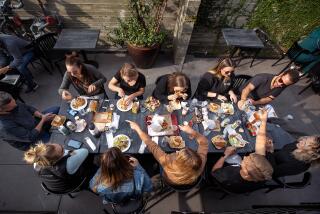Pantry Raid: Vegan doesn’t necessarily mean healthy
Every so often, we take a candid look at the private dietary lives of people whose food choices need a makeover. Up this week: the kitchen and dining habits of 22-year-old Jessica Watson and her boyfriend, 31-year-old Todd Preboski.
She’s a vegan; he eats fish but no other animal-based foods.
Such diets may conjure up images of fresh vegetables and fruits, nuts, tofu and whole grains. But a lack of time and planning have cornered the couple into relying too often on Taco Bell burritos, protein bars and potato chips. They cook few dinners at home, and Watson’s diet is dangerously low in protein and calcium. Neither gets all the vitamins and minerals needed; even some of the processed vegan foods they favor are low in essential nutrients.
“I got into being a vegan to have less of an environmental impact,” says Watson, a graduate student at Cal State Fullerton and a receptionist. “Growing all of my own vegetables or getting foods from the farmer’s market — I want to do these things. I want to be better at being vegan and being healthier too.”
A perusal of their refrigerator and cupboards shows the couple is clearly making an effort. They may be temporarily low on fruits and vegetables, but the refrigerator and freezer hold vegan hot dogs, spelt buns, meatless Boca burgers, vegan cheese, faux turkey crumbles, cartons of almond milk, acai puree, vegan mayonnaise and a $6 package of vegan marshmallows.
“It’s not cheap being this idealistic,” Preboski says wryly. He’s a cable company lineman and a drummer in a band.
But what looks healthful at first glance may not be so, as registered dietitian Lisa Gibson, an Irvine-based private consultant, discovers on a recent weeknight. That almond milk? Only 1 gram of protein per 8-ounce serving; a serving of nonfat dairy milk provides about 8 grams of protein per serving. The vegan cheese? Also 1 gram of protein per 1/4-cup serving, plus zero calcium. The first ingredient is water. Compare that with about 7 grams of protein and about 200 milligrams of calcium in 1 ounce of cheddar cheese.
“A lot of times people think the substitutions they’re making are going to be healthier for them, but they’re not,” Gibson says. “They can be worse, because you’re not getting the nutrients you need.”
Watson is a die-hard reader of nutrition labels, but she checks primarily to make sure the items are animal-free.
Gibson makes a suggestion: “Look at what you’re actually getting in these foods.... You want to look for nutrient-dense foods.”
The cupboard reveals mostly good things: spelt flour, gourmet baking chocolate, high-protein pretzels, plus cans of green beans, lentils and garbanzo beans, and cans of pumpkin pie filling.
In the backyard is a planter filled with lettuce, tomatoes, herbs, and chile and bell peppers — a new addition that exemplifies the couple’s attempt to eat more fresh produce. The couple pick red leaf lettuce and tomatoes for that night’s salad; the main course is spaghetti and meatless meatballs made of mushrooms and textured soy and wheat protein.
The meal is far more healthful than what they usually eat during the day. Watson has a habit of grazing on simple, low-nutrient carbs — potato chips, crackers, cookies, the occasional protein bar — saying heavy meals make her feel lethargic. But Gibson points out that those snacks don’t supply enough nutrients and will lead to blood-sugar crashes; she recommends light meals that combine complex carbs with protein and, if necessary, nutritious, filling snacks such as fruit, a handful of peanuts or a slice of whole-grain bread with peanut butter.
“How much protein do you think you need a day?” Gibson asks Watson.
“I probably need, like, 10 grams? No? Twenty? Thirty?”
The answer: between 46 and 54 grams per day. “You need it for your muscles, your hair, your blood,” Gibson says. “If you don’t have essential amino acids, your body is not going to make new blood cells.”
After looking over Watson’s three-day diet diary, Gibson thinks the couple is getting enough calories. But the current lack of calcium could set Watson up for osteoporosis later.
Gibson suggests calcium supplements for Watson and says that B-12 and iron supplements might be in order, as well. Although soy milk is fortified with B-12 and calcium, and breakfast cereals are often fortified with B-12, most people get the vitamin through meat. Dark, leafy green vegetables contain iron, although it is not always that well absorbed.
Preboski’s breakfast is typically no more than a cup of coffee and an occasional piece of fruit. For lunch, he’ll sometimes have canned soup at home, but his work schedule occasionally forces him to eat out, usually fast food. Gibson suggests steel-cut oatmeal for breakfast — made in advance to save time and with added nuts to contribute to the 71 to 80 grams of protein he needs daily. Obviously, she adds, a nutritious packed lunch trumps fast food.
As for dinners, mapping out a few meals in advance — with a repertoire of about six main recipes — will solve the what’s-for-dinner dilemma, Gibson says. Even taking some cooking classes or watching instructional cooking shows on television or the Internet might help.
That appeals to Watson. “I don’t want to be that kind of vegan who goes to Taco Bell and gets a burrito but minus the sour cream and cheese. How good is that for you, really? I want to be more certain about what I’m eating.”
More to Read
Eat your way across L.A.
Get our weekly Tasting Notes newsletter for reviews, news and more.
You may occasionally receive promotional content from the Los Angeles Times.








